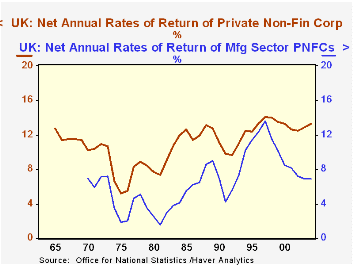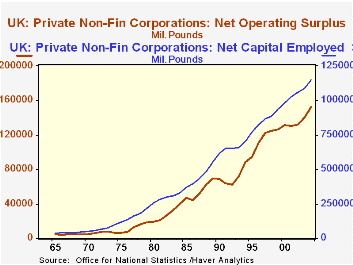 Global| Jul 06 2005
Global| Jul 06 2005UK Corporations Achieve High Profitability in Q1, Led by Oil Companies and Service Industries
Summary
Net rates of return for UK corporations have run strong in the last several quarters. The first quarter's outcome, 13.3%, was the third highest in the 16-year history of these quarterly data. These figures on corporate profitability [...]

Net rates of return for UK corporations have run strong in the last several quarters. The first quarter's outcome, 13.3%, was the third highest in the 16-year history of these quarterly data. These figures on corporate profitability were reported yesterday, July 5, by the UK Office of National Statistics and have just recently been added to Haver's UK database. The information, called "Profitability of UK Companies", is listed in both the Financial Data and National Accounts menus.
The rates of return are defined as the ratio of the net operating surplus to net capital employed. [The values in "gross" terms, i.e., before the deduction of capital consumption, are also published, but the "net" data get far more attention.] The factors in the ratio, net operating surplus and net capital employed, are published annually; rates of return are available quarterly for all private non-financial corporations and three categories: "Continental Shelf" companies, manufacturing firms and service sector companies. "Continental Shelf" refers to the UK petroleum industry.
In the first quarter, the 13.3% overall return represented a pick-up from the fourth quarter's 13.1% and was equal to the 2004 average of 13.3%. As might be expected, the Continental Shelf firms saw a boost in their return, to 29.6%, up from the prior quarter; the last five years have averaged 30.8%, the highest ever, with a range among individual quarters of 25.6%, right after 9/11, to 38.1% at the end of 2000.
Non-financial service industries experienced their strongest returns in the late 1990s. We'd speculate that computer software developers, internet companies and other tech firms led this high-profit time in the UK, when returns on capital peaked at 19.5% in the second quarter of 1998. The recent period, while lower, isn't "bad", with profitability still running at about 16.5% on average and this latest quarter at 17.5%.
Manufacturing returns have lagged. This has been so for a long time, throughout the history of these data back to 1970. The worst performance was during the energy "crisis"/stagflation recessions of the late 1970s and early 1980s, when, for instance, the net return dipped to just 1.5% in 1981. More currently, manufacturing firms saw good results from 1994 to 1999, but since then have fallen back to single-digits. The 6.0% in Q1 is among the lowest since the 1991 recession. The ONS suggests that the lower returns in manufacturing reflect their higher capital intensity, compared with service firms. This is certainly true, but perhaps their greater cyclicality and variability also restrain their overall performance.
| UK: % except as noted |
Q1 2005 | Q4 2004 | Q3 2003 | 2004 | 2003 | 2002 |
|---|---|---|---|---|---|---|
| Net Rate of Return: All PNFCs* | 13.3 | 13.1 | 13.4 | 13.3 | 12.9 | 12.5 |
| Net Operating Surplus (£ Billions) | 152.2 | 140.2 | 132.2 | |||
| Net Capital Employed (£ Billions) | 1146.4 | 1089.4 | 1056.5 | |||
| Continental Shelf Companies** | 29.6 | 27.6 | 30.5 | 29.1 | 29.2 | 30.4 |
| Manufacturing | 6.0 | 7.7 | 5.8 | 6.9 | 6.9 | 7.2 |
| Service Sector | 17.5 | 15.9 | 16.4 | 16.5 | 16.5 | 16.1 |
Carol Stone, CBE
AuthorMore in Author Profile »Carol Stone, CBE came to Haver Analytics in 2003 following more than 35 years as a financial market economist at major Wall Street financial institutions, most especially Merrill Lynch and Nomura Securities. She had broad experience in analysis and forecasting of flow-of-funds accounts, the federal budget and Federal Reserve operations. At Nomura Securities, among other duties, she developed various indicator forecasting tools and edited a daily global publication produced in London and New York for readers in Tokyo. At Haver Analytics, Carol was a member of the Research Department, aiding database managers with research and documentation efforts, as well as posting commentary on select economic reports. In addition, she conducted Ways-of-the-World, a blog on economic issues for an Episcopal-Church-affiliated website, The Geranium Farm. During her career, Carol served as an officer of the Money Marketeers and the Downtown Economists Club. She had a PhD from NYU's Stern School of Business. She lived in Brooklyn, New York, and had a weekend home on Long Island.





